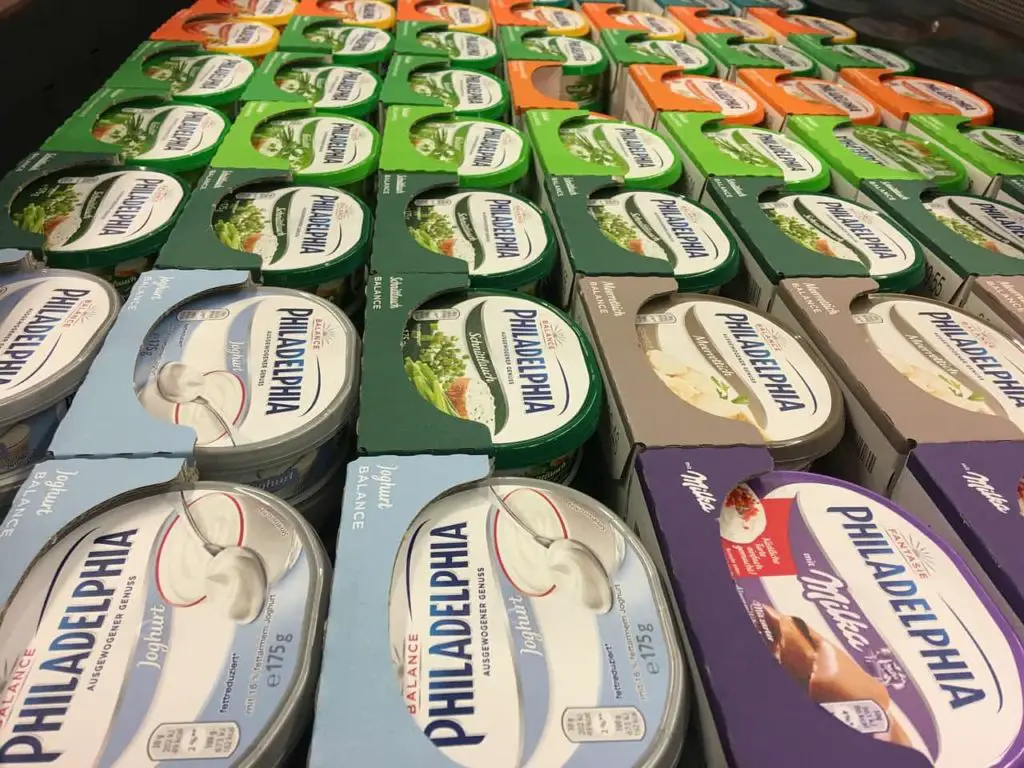Maybe you’ve run out of ways to use your Philadelphia cream cheese, or you don’t want it for practically every meal, but it’s near its expiration date, and you don’t want to waste it.
Luckily, you can freeze Philadelphia cream cheese.

Unfortunately, it does limit the way that you can use it once you defrost it, as it’s never quite the same.
It’s not recommended, for example, trying to use it as a spread once you defrost it, or as a dip, as the texture completely changes.
So, how can you freeze it? What can you use defrosted Philadelphia cream cheese for? Keep reading to discover everything you need to know.
Can You Freeze Philadelphia Cream Cheese?
Yes, you can freeze Philadelphia cream cheese without any huge issues. That is, provided that you freeze and defrost it correctly, but once you defrost it the consistency does change.
While you know it to be smooth, and creamy in texture, the cheese gets a little lumpy, as well as becoming much thinner. This makes it unsuitable for using as spreads and dips. It can also get slightly grainy.
The company suggests that you shouldn’t freeze it, not because it is dangerous, but because there’s a noticeable loss in quality in the texture. It’s no longer creamy.
When you first defrost it, it will look absolutely fine. There will be a few parts where the liquid has separated, noticeably around the edges, until you stir it all back together.
While it looks okay to start with, it takes on the texture of thin yogurt, and loses its lovely smoothness.
While this can affect how you use it, it doesn’t mean that you should put it in the trash, as it’s still a very useful ingredient to have.
You can mitigate this in different ways, either by increasing the amounts of other ingredients to add to your dish, or use it in a bake. If you’re interested in this part and nothing else, you can skip ahead to the relevant section below.
Can You Freeze Philadelphia Cream Cheese Blocks and Spreads?
Both the Philadelphia spreads and blocks can be frozen. But is there a difference between how defrosting affects them?
Before you begin, the cream cheese spreads are much softer, designed to spread well, while the blocks are more solid, and you’ll have a hard time spreading them.
Both change texture after being frozen. The Philadelphia blocks have a lower moisture content than the spreads, making the change less dramatic when defrosted. It’s still noticeable, however.
Make sure there is a little gap in between the cream cheese and the container, and ensure it’s sealed well.
This will stop the freezer burn, as the worst thing you can do is expose it to the air inside your freezer.
Putting the cheese in a container that’s not airtight will result in a dramatic change within the texture of your Philadelphia cream cheese, and the ultimate results will be largely unpleasant.
Can You Freeze Philadelphia Cheesecake Filling?
It’s not the best thing to freeze, really. The Philadelphia cheesecake filling also changes consistency once it has defrosted, making it pretty unfit for its purpose as-is once it’s been frozen and defrosted.
It’s much easier to freeze an entire cheesecake (see also How To Freeze Cheesecake) after you’ve baked it, once it’s cold, of course. Doing it this way will mean that you won’t have to worry about any consistency problems, as it is already baked.
Philadelphia cheesecake filling will also keep for 3 days in the fridge, which should give you some breathing room when it comes to finding the time to make it.
Failing that, you can try and alter the texture of the Philadelphia cheesecake filling after it has defrosted, though this will be difficult.
Can You Freeze Philadelphia Cream Cheese Dips and Spreads?
It’s not recommended trying to freeze Philadelphia cream cheese dips (see also Can You Freeze Cheese Dip) and spreads. As these products are made from similar ingredients as the cream cheese, it’s unlikely that the texture won’t change after you defrost it.
Most likely, these will change dramatically in consistency, so you may want to hold off on putting these products in the freezer.
Having said that, there’s nothing to stop you from attempting it! Experiment with a much smaller amount, and that way you don’t run a whole tubs worth of cream cheese spread or dip just to see what would happen.
It’s also worth removing any liquid that becomes separated from the rest of the cheese before you stir it, which will help prevent it from becoming too watery.
If it doesn’t turn out well, there’s your answer. You’ll just have to use it fresh!
The Best Way to Freeze Philadelphia Cream Cheese
The first thing to do is plan ahead. As cream cheese freezes as a solid, you will find it very difficult to try and portion it once it is frozen.
You should divide it up before freezing, and that way you’ve taken out all the guesswork you’d have to do later on.
Once you know what you will use it for, you can portion it into appropriate sizes in airtight containers.
It also helps that the cream cheese itself comes in a container that’s easily freezable. It’s perfect when you haven’t opened it, just throw it into the freezer as is.
If you want to freeze Philadelphia blocks, put them into suitable containers – without leaving the wrapping on – and label when you froze it, and what it is.
How Long Can You Freeze Philadelphia Cream Cheese Before You Have to Use It?
Philadelphia cream cheese will last a maximum of 3 months in the freezer before it starts to lose its quality.
Like most food, the longer it stays in the freezer, the more time it has to lose its taste. Considering that these products aren’t recommended for freezing, this timescale is pretty good.
How Do You Defrost Philadelphia Cream Cheese?
The best way to defrost Philadelphia cream cheese is to put the container in the fridge.
How long it will take to defrost really depends on how much cream cheese you have, and the more you’ve got, the longer it will take to defrost.
If you want to cut the time it needs to defrost, pop the cheese container into a bowl of tepid water, and place the whole thing in the fridge.
The water conducts heat noticeably faster than it travels through air, and so long as you keep the lid of the cheese on tight, there won’t be any adverse effects.
If it’s not a monster portion of Philadelphia cream cheese, you can simply leave it overnight in the fridge to defrost.
What to Do With Separated Cream Cheese After Defrosting
Once you’ve defrosted the cream cheese, you’ll notice that the liquid will have separated, leaving an uneven and unpleasant texture. If you want a runny cream cheese, simply stir it.
If you’d prefer something more solid, get rid of the excess liquid. Once you’ve done this, it’ll be ready to use.
What Can You Use Defrosted Philadelphia Cream Cheese In?
You can use defrosted Philadelphia cream cheese in a myriad of ways, so long as you keep in mind that the texture will be different.
For example, if you’re planning to use the defrosted Philadelphia cream cheese in a pancake mixture (see also Freezing Pancake Batter), it can make the mixture too runny, and you’ll need to adjust the recipe accordingly to get those all-important fluffy pancakes.
You could use Philadelphia cream cheese which has been defrosted in baking (see also Freezing Cream Cheese Frosting), or as filling in cheesecakes, but it isn’t suitable as a topping, as it’s simply not thick enough.
You can also use it in casseroles, or as part of omelets, frittatas, or anything else you can think of where the consistency of the cream cheese doesn’t matter so much.
It’s also helpful to use defrosted Philadelphia cream cheese in dishes you’ve made before. If you’re familiar with the recipe and the texture at each stage, you’ll know how to fix it, if you need to.
It’s also handy to use the Philadelphia cream cheese in some dishes that require a more runny consistency, so you don’t need to add extra liquid.
Extra liquid might not be a problem, but you might also have to adjust the other ingredients, so you get more of a flavorful impact.
For example, if you’re using the Philadelphia cream cheese in pasta bakes (see also Freezing Ziti Pasta), you may have to add extra cheese, flour, or another ingredient in order to thicken the sauce, and to provide more flavor.
You can also use defrosted Philadelphia cream cheese in order to flavor meat, but do bear in mind that it will be much runnier, so you’ll need to use it slightly differently.
If you wanted, you can also whisk or even microwave it to get that creamy texture back, but you do risk making it worse. Heat it for ten seconds at the very most!
It’s also worth knowing that low-fat versions of the Philadelphia cream cheese will not freeze as well as the normal variety, as a higher fat content stops it separating as much.

How to Tell If Your Philadelphia Cream Cheese Has Gone Bad
It’s also important to know if your Philadelphia cream cheese has defrosted properly, or if something has gone wrong, and it’s gone off.
If the texture is slimier than you expected, don’t use it. If it has discolored rather than just separated after defrosting, don’t chance it. If it doesn’t smell good, it’s time to bin it!
If you’re in any doubt that your Philadelphia cream cheese is safe to eat, it’s best to be overcautious, as dairy can be temperamental.

